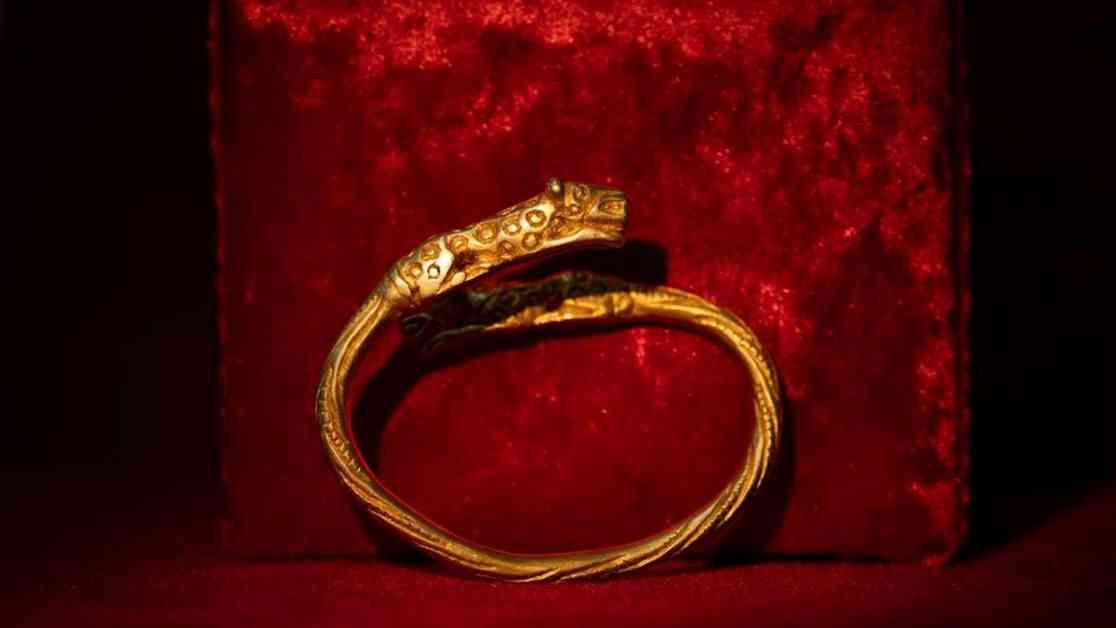Ancient Gold Jewelry Unearthed in Kazakhstan Reveals Sarmatian Culture
In a fascinating discovery that sheds light on the ancient Sarmatian culture, striking gold jewelry and weapons have been unearthed from three burial mounds in Kazakhstan, dating back to around the fifth century B.C. These artifacts offer a glimpse into the rich history of the Sarmatians, nomadic tribes that once dominated the steppe between Eastern Europe and Central Asia.
The Excavation Expedition
Led by archaeologist Marat Kassenov, the excavation team uncovered more than 1,000 artifacts from the Atyrau region, just north of the Caspian Sea. Among these treasures were over 100 gold ornaments and jewelry pieces adorned with intricate “animalistic” Sarmatian designs. Images of leopards, wild boars, and tigers, reflecting the predators of the region at the time, were prominently featured on these artifacts.
The significance of these finds cannot be overstated, as they challenge previous assumptions about the extent of Sarmatian territories. While scientists once believed Atyrau to be on the periphery of Sarmatian influence, the discoveries now suggest it may have been a central hub of Sarmatian civilization. This revelation has sparked new interest and excitement in the archaeological community, prompting further exploration and study.
Unveiling a Rich Cultural Tapestry
The artifacts unearthed from the burial mounds paint a vivid picture of Sarmatian life and customs. In addition to the gold jewelry, the team discovered human remains, ceramics, and two rare wooden bowls that had miraculously survived the test of time. Of particular interest were two black “touchstones” with gold handles, likely used to assess the purity of metals such as gold—a testament to the Sarmatians’ advanced metallurgical knowledge.
The Sarmatians, renowned for their prowess as horse nomads, roamed the vast steppes between Europe and Asia for centuries. Their cultural legacy, steeped in myth and legend, continues to captivate historians and archaeologists alike. From their alliances with the Goths and Germanic tribes to their service as heavy cavalry for the Byzantine Empire, the Sarmatians left an indelible mark on the annals of history.
Exploring the Karabau-2 Kurgan
Many of the artifacts were recovered during excavations of the “Karabau-2” burial mound in the Atyrau region, a site of immense historical significance. This kurgan, standing at 10 feet high and boasting a diameter of 230 feet, served as the final resting place for at least nine individuals. Despite some instances of looting, the archaeologists managed to unearth a treasure trove of artifacts, shedding light on the opulence of Sarmatian burials.
Venturing beyond the Karabau-2 kurgan, the team excavated two additional burial mounds in close proximity, each revealing between 10 and 15 graves. These sites yielded a wealth of iron and bronze weapons, jewelry, household items, and silver “pictograms” depicting animals like the saiga antelope and wolf. Notably, one grave contained a stunning gold bracelet weighing a hefty 13 ounces—an emblem of wealth and status among the Sarmatians.
Unraveling the Mysteries of the Past
As archaeologists continue to unravel the mysteries of the Sarmatian civilization, each new discovery brings us closer to understanding the complexities of this ancient culture. Through the lens of history, we gain insight into the lives and beliefs of these nomadic tribes, whose legacy endures in the artifacts buried beneath the Kazakh steppes.
In the words of renowned archaeologist Marat Kassenov, the artifacts unearthed in Kazakhstan offer a window into a bygone era, where the shimmering gold jewelry and intricate designs of leopards and tigers speak volumes about the creativity and craftsmanship of the Sarmatian people. As we delve deeper into the annals of history, we are reminded of the enduring power of human ingenuity and the timeless allure of ancient treasures.










